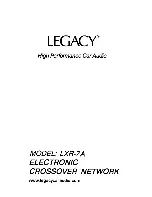
FRONT PANEL DESCRIPTION
1. INPUT OVERLOAD INDICATOR.
This red LED will illuminate any time the input stage
is driven to within 4 dB of clipping. This level is a function of both input signal level and the
position of the input gain control.
2. INPUT LEVEL CONTROL.
This rotary control determines the input gain of the cross-
over. Its range is from -20 dB to +6 dB. The majority of applications should find this control
set at 0 dB for unity gain.
3. HIGH OUTPUT OVERLOAD INDICATOR.
This red LED will illuminate anytime the
high frequency output of the crossover is driven to within 4 dB of clipping. This level is a func-
tion of both the input level and the high frequency output level control.
4. HIGH OUTPUT LEVEL CONTROL.
This rotary control determines the amount of gain
to follow the high frequency output of the crossover’s frequency dividing network. Its range
covers Off to +6 dB.
5. HIGH FREQUENCY INVERT SWITCH.
This two position slide switch electrically in-
verts the high output in the INV position. This may be necessary where drivers or amplifiers
are tied incorrectly or when the crossover’s phase control lacks sufficient range (more than
180 degrees becomes necessary).
6. HIGH FREQUENCY MUTE SWITCH.
In its in position, all output signal from the high
output of the crossover will be totally muted. This is to be used when initially setting levels of
the low output and during the phase alignment process.
7. HORN EQ DEFEAT SWITCH.
If a constant-directivity horn is to used on the high output,
set this switch to the IN position.
8. HORN EQ FREQUENCY CONTROL.
This rotary control allow a continuously variable
adjustment of the frequency at which boost begins to occur. This should be set based on the
horn manufacturer’s recommendation.
9. CROSSOVER FREQUENCY SELECTOR.
This rotary control offers 24 precise frequen-
cies at which the crossover makes the divide between the high and low outputs. It is a binary
encoding switch which sets up the digital control of the filter’s frequency dividing circuits for
very high precision.
10. PHASE CONTROL BYPASS SWITCH.
In its “OUT” position, the phase control has no
effect on the low frequency output.
11. PHASE ANGLE CONTROL.
This rotary control provides a constantly variable 0 to 180
degree phase shift between the low and high outputs.
13. LOW FREQUENCY OVERLOAD INDICATOR.
This red LED illuminates any time the
Low Output comes within 4 dB of clipping. This level is a function of input level as well as low
frequency output level.
13. LOW FREQUENCY LEVEL CONTROL.
This rotary control wits the output gain of
the low frequency section from Off to +6 dB.
14. LOW FREQUENCY INVERT SWITCH.
This switch electrically inverts the polarity of
the low output in the “INV” position. This may be necessary for many of the same reasons
cited in #5, above.
15. LOW FREQUENCY MUTE SWITCH.
Identical to #6, above with the exception that it
mutes the low output.
16. POWER INDICATOR.
Illuminates whenever the correct AC power is applied to the unit
from a remote power supply.









